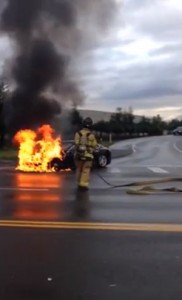 With gasoline prices expected to stay low for the near-term future, new vehicle sales figures for plug-in electric vehicles (EVs) and hybrids are expected to stay stagnant for now along with softening residual values. What might it take for these numbers to see an increase? Green Auto Market spoke with an expert on the subject – Eric Lyman, VP, industry insights at ALG – to gain insight on key market indicators to follow.
With gasoline prices expected to stay low for the near-term future, new vehicle sales figures for plug-in electric vehicles (EVs) and hybrids are expected to stay stagnant for now along with softening residual values. What might it take for these numbers to see an increase? Green Auto Market spoke with an expert on the subject – Eric Lyman, VP, industry insights at ALG – to gain insight on key market indicators to follow.
The phone conversation with Lyman came out of a meeting with John Krafcik, president of TrueCar at NADA 2015 in San Francisco. There’s been a strong correlation between full-size pickups doing much better in sales and the Toyota Prius seeing a decline in the hybrid’s sales numbers with gas prices dropping since last summer. When asked what it might take to reach interested consumers beyond the issue of gas prices, Krafcik thought it would make sense to check in with Lyman for more perspective from ALG (a TrueCar company).
Beyond the early adopters and new-technology first-in-line buyers, ALG finds the interest is there for EVs and hybrids, but car shoppers today are not that willing to pay for it. For now, consumers are responding best to two themes, it’s an environmental statement and it’s a statement of affluence, Lyman said. ALG surveys have shown that for the overall consumer market, the “efficiency is great and less time is spent at gas stations,” Lyman said. “But they’re still not willing to pay for it.”
Car shoppers in affluent communities have been willing to switch from driving a Mercedes S Class to a $125,000 Tesla Model S out of fascination with the new technology. It also appeals to their statement of success and affluence, and making a positive difference in the environment, according to Lyman.
Beyond that niche market, incentives and gaining access to carpool lanes in states like California have helped gain consumer interest in EVs. The $7,500 federal tax credit is applied to lease payments by captive finance companies like Nissan Motor Acceptance Corp. on the all-electric Nissan Leaf. State rebates are built into the lease just like the federal tax credit, he said. For those purchasing their own Leafs or other EVs, the federal tax credit adds to the complexity of the car buying experience, Lyman said, as the consumer decides how to add the credit into their tax payment by April 15.
ALG conducted a three-year study on the perceived quality of alternative powertrains, with the third edition being released in late 2012. At the time, there were several new automaker brands out there vying for attention and credibility on the market. “There were several brands emerging at the time, such as Zenn, ZAP, Coda, Fisker, and BYD, but they had no history in the marketplace,” Lyman said. “Consumers were almost indifferent to the brands – interest in innovative, new technology was a bigger issue.”
Much has changed since that time – with some of those brands gone from the market or put on hold. Mainstream brands had a substantial advantage in perceived quality at that time, though alternative powertrain manufacturers were improving in the study. Tesla was the most highly rated alternative powertrain brand. For several major automakers, EVs were perceived as a “side project,” Lyman said.
For residual values, Tesla has been the only solid EV performer so far. “They’ve done an amazing job of building the brand with early adopters, achieving a cult status,” he said. Tesla Motors took a non-traditional path in funding. For the original Tesla lease program on the Model S, no federal tax credit could be applied, according to Lyman. Now the agreement with US Bank has made that incentive available for the Model S.
For consumers, the “breakeven point” is a bit long in this period of low gasoline prices, Lyman said. “It can take five-to-six years for hybrids to break even” with comparable non-hybrid models, he said. “Diesel can take 10 years.” Lyman has seen diesel up about 70 cents a gallon over gasoline in some markets, making it a tougher sell for US consumers.
Here are some other points Lyman made to keep in mind:
- Maintenance is a strong selling point for EVs compared to internal combustion engine vehicles. “It’s a real opportunity – they don’t have the same maintenance components such as oil changes and moving parts,” he said.
- Fleets are still very new to EV drivetrains. “EV technology doesn’t really apply to daily rental,” he said. “Commercial and government fleets amortize vehicles down to zero, which could take 10 years.”
- Consumers are “extremely well informed” and have done their research on the green car technology they’re shopping for. It creates a “situation” for dealers when consumers know more.
- Green cars still make up a small percentage of new vehicle sales – about 5% for hybrids, EVs, and diesel passenger cars. It’s going to take a while to gain confidence in new technologies by consumers, he said.
- It will take a few years for EVs to see more strength in residual values. A good example of how this happens comes from the first years of the Toyota Prius, Lyman said. “The first generation Prius appreciated about $4,000 over the first six months after introduction of the second-gen Prius.”

